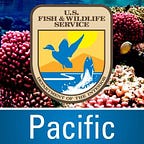The Hawaiʻi Fish Habitat Partnership Seeks Proposals for Aquatic Habitat Conservation Projects
By Jordan Akiyama, Public Affairs Specialist, U.S. Fish and Wildlife Service
The Hawaiʻi Fish Habitat Partnership is seeking proposals for aquatic habitat conservation projects involving streams, estuaries, and nearshore marine habitats on the main Hawaiian Islands. Projects developed in coordination with the Hawaiʻi FHP may be eligible for funding through the National Fish Habitat Partnership (NFHP).
All projects submitted for funding will be reviewed by the Hawaiʻi FHP Steering Committee. The Hawaiʻi FHP administers financial assistance awards of up to $125,000 for fish passage improvements and aquatic habitat restoration. A minimum one-to-one non-federal match is required. Successful applicants will have funding in place in the second quarter of 2023. Projects scheduled for completion between 12 to 18 months are preferred.
On-the-ground aquatic habitat conservation projects are given highest priority, especially “shovel-ready” projects that have completed environmental compliance requirements. If funding permits, secondary consideration may be given to support aquatic habitat conservation project planning and design, or applied research that will guide future Hawaiʻi FHP aquatic habitat conservation activities such as engineering for fish passage projects, regional aquatic habitat assessments, aquatic invasive species control, and analysis of potential climate change impacts to aquatic systems. Outcomes must closely address the priority objectives of the Hawaiʻi FHP Strategic Plan and the national goals of NFHP. Projects located in priority watersheds and habitat types identified in the Hawaiʻi FHP Strategic Plan are preferred.
Hawaiʻi FHP objectives are to:
- Preserve and improve habitat connectivity by reducing impacts of barriers to native species passage.
- Develop and implement conservation projects that link inland and nearshore marine ecosystems to protect, restore, and maintain self-sustaining aquatic communities.
- Support regional habitat assessments and applied research to obtain data to guide conservation, management and recovery programs in stream, estuarine, and nearshore marine waters.
Proposals are due no later than February 28, 2022. Applicants will be required to discuss the project with the Hawaiʻi FHP coordinator in advance of proposal submission to ensure their project is suitable for the grant program. Proposals should be between four to six pages in length, and include a budget table, timeline, list of required permits, location and site map, and photos/illustrations. The project narrative must contain descriptions of planned project activities, identify measurable outcomes, and highlight the recreationally and culturally important aquatic species expected to benefit from the project. A monitoring plan that evaluates project results must be described in the proposal.
The U.S. Fish and Wildlife Service works with others to conserve, protect, and enhance fish, wildlife, plants, and their habitats for the continuing benefit of the American people. For more information, connect with us through any of these social media channels at https://www.facebook.com/PacificIslandsFWS, www.flickr.com/photos/usfwspacific/, or www.twitter.com/USFWSPacific.
